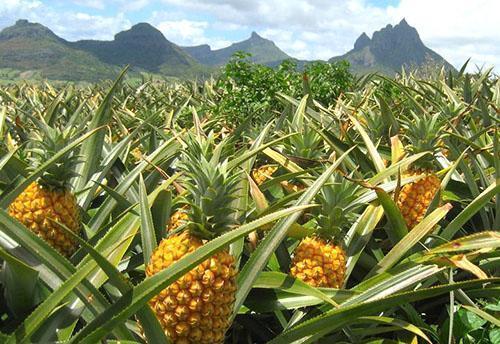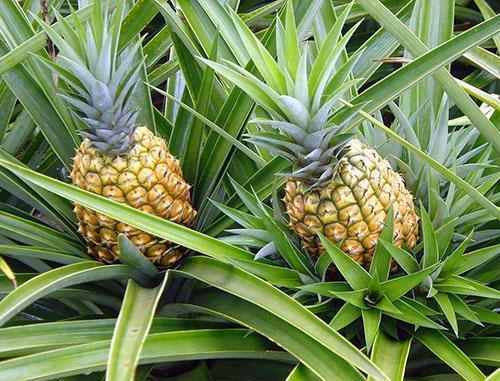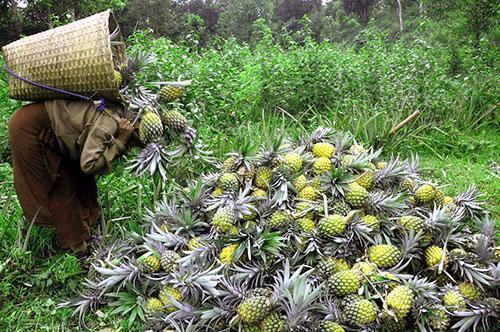Do you want to know where pineapple grows in natural conditions?
 Among tropical fruits, pineapples are the third largest cultivated. In the countries of the tropical zone, the cultivation of pineapples is becoming one of the most important articles of agriculture. Therefore, literally all over the world, you can find plantations where pineapples grow, but in nature you will hardly be able to see sweet fruits familiar from store shelves.
Among tropical fruits, pineapples are the third largest cultivated. In the countries of the tropical zone, the cultivation of pineapples is becoming one of the most important articles of agriculture. Therefore, literally all over the world, you can find plantations where pineapples grow, but in nature you will hardly be able to see sweet fruits familiar from store shelves.
The fact is that all pineapples intended for human consumption belong to the subspecies Ananas comosus var. comosus, which currently consists of several dozen varieties and cultivated hybrids. In the wild, pineapple plants of this subspecies are not found. In addition to the comosus variety, the Ananas Comosus species is presented in four more varieties: Ananassoides, Erectifolius, Parguazensis and Bracteatus. All representatives of the species are inhabitants of tropical regions of South America that share common features and belong to the bromeliad family.
Even in the pre-Columbian era, local residents grew and used pineapples. Moreover, not only edible fruits were used, but also the tough leaves and stems of pineapple plants, from which strong fiber was obtained for the production of clothing, ropes, mats and fishing nets.
What does this interesting plant look like, and what does the well-known tropical fruit pineapple represent?
Botanical description of the pineapple plant

The rosette of an adult plant is formed from 30 or more fleshy, concave, pointed leaves 20 to 100 cm long. It is interesting that the foliage is arranged in a spiral on a thickening stem as it grows. In some varieties and subspecies of pineapple, sharp curved thorns can be seen along the edge of the leaves.
There are subspecies with both evenly colored leaves and variegated varieties. But in all representatives of the genus, the foliage is covered with a thick waxy bloom, making it almost gray or gray.
How does pineapple bloom?
 Few of the people who are used to feasting on tropical fruit imagine how pineapple blooms. Nevertheless, it is interesting not only how the flower itself looks, but also how pineapple plants are prepared for flowering on industrial plantations.
Few of the people who are used to feasting on tropical fruit imagine how pineapple blooms. Nevertheless, it is interesting not only how the flower itself looks, but also how pineapple plants are prepared for flowering on industrial plantations.
Usually the culture is ready to bloom in 12-20 months after planting. Since the formation of a peduncle in this species can be significantly delayed, some tricks are used to obtain a friendly harvest on plantations where pineapples grow. Plants are either fumigated with smoke several times, or, which happens much more often, treated with acetylene. Such a measure stimulates plants to form flower buds, and after a couple of months you can see how the upper part of the stem lengthens, and an inflorescence appears on it.
 The length of the pineapple inflorescence is from 7 to 15 centimeters. At the same time, it includes from 100 to 200 small flowers arranged in a spiral, tightly sitting on the stem and surrounded by a bracts.
The length of the pineapple inflorescence is from 7 to 15 centimeters. At the same time, it includes from 100 to 200 small flowers arranged in a spiral, tightly sitting on the stem and surrounded by a bracts.
The color of the corollas can be, depending on the variety, different shades of raspberry, lilac or purple.
Since the formation of seeds that occurs during cross-pollination, according to the producers of tropical fruits, the pineapple and its qualities are negatively reflected, flowering plantations are protected in every possible way. For this, the inflorescences are covered with caps, and in Hawaii, where hummingbirds are the pollinator of the crop, plantings have to be strictly protected from these tiny birds.
 On the stem, flowers and then individual fruits on pineapple plants are arranged in accordance with the sequence of Fibonacci numbers, forming two interconnected spirals.
On the stem, flowers and then individual fruits on pineapple plants are arranged in accordance with the sequence of Fibonacci numbers, forming two interconnected spirals.
As soon as the ovaries are formed and their growth begins, the individual berries merge, so that as a result, a fruit appears on the shelves with a juicy single core and dense prickly skin.
Due to the fact that there are practically no seeds in the fruits of cultivated varieties, reproduction is carried out exclusively in a vegetative way. After harvesting, the old pineapple plants are removed, and new ones are planted in their place, obtained from the lateral processes, in abundance formed in the leaf axils and at the very root. As a result, the variety of plants is maintained and their cultivation is accelerated.
Obviously, modern cultivation technology was not known either in the pre-Columbian era, or later, when the first Europeans appeared in the South American region. What is the origin of the pineapple? When, by whom, and where was pineapple first discovered?
Discovery history and origin of pineapple
 According to today's scientists, the area stretching from southern Brazil to Paraguay can be considered the birthplace of pineapple.
According to today's scientists, the area stretching from southern Brazil to Paraguay can be considered the birthplace of pineapple.
Plants closest to the modern species Ananas comosus were found at the beginning of the last century in the Parana River valley.
Obviously, from these regions, local tribes, who learned to eat juicy fruit fruits, spread pineapples throughout most of the South American continent up to the Caribbean and Central America. It is known that the pineapple plants were cultivated by the Aztec and Maya tribes. The discovery of the tropical pineapple fruit by Europeans took place in 1493, when Columbus noticed interesting plants on the island of Guadeloupe. With the light hand of the navigator, the pineapple was named "Pina de Indes".
If the Spaniards found pineapples in Hawaii, the Portuguese found plants that struck them no less in Brazil. And after a few decades, the first pineapple plantings appeared in Indian and African colonies. The rapidly gaining popularity of the tropical fruit has retained its name from the indigenous South Americans, because "nanas" in the language of the Tupi Indians means "magnificent fruit". The prefix comosus, that is, crested, appeared in 1555.
Growing pineapple: tropical fruits in Europe
 As exotic tropical fruits, pineapples quickly gained popularity in Europe. However, their delivery from overseas colonies to European states was not only expensive, but also extremely long. During the sea voyage, most of the fruit was hopelessly spoiled. Therefore, already in 1658, the first European fruit was grown, and in 1723 a huge greenhouse was built in Chelsea, England, intended exclusively for this tropical crop.
As exotic tropical fruits, pineapples quickly gained popularity in Europe. However, their delivery from overseas colonies to European states was not only expensive, but also extremely long. During the sea voyage, most of the fruit was hopelessly spoiled. Therefore, already in 1658, the first European fruit was grown, and in 1723 a huge greenhouse was built in Chelsea, England, intended exclusively for this tropical crop.
Pineapples became so popular and fashionable that their images appeared on the portraits of royalty, and the rulers wanted their own outlandish "cones" to be grown in their possessions. For example, a portrait with a pineapple of King Henry II is known; in 1733, a pineapple from his own greenhouse in Versailles appeared on the table of Louis XV. And Catherine II received fruits from her Petersburg farms before her death.
But, despite the fact that pineapples did not grow in nature, but already in Europe, they did not become cheaper and more accessible.It took at least two years to get the precious fruit, and it was expensive to maintain greenhouses and grow a capricious crop. Therefore, pineapples were considered a symbol of luxury, and at dinner parties they were often not eaten, but used as decoration and proof of wealth. The same fruit was used to decorate the table many times until it rotted.
 Stylized images of pineapple, a tropical fruit for the wealthy, were increasingly used to decorate interiors and clothing. And in the second half of the 18th century, in the possession of the fourth Earl of Dunmore, John Murray, who was engaged in the cultivation of pineapples for the English nobility, a greenhouse appeared, the attraction of which was a huge dome in the shape of a bizarre stone pineapple 14 meters high.
Stylized images of pineapple, a tropical fruit for the wealthy, were increasingly used to decorate interiors and clothing. And in the second half of the 18th century, in the possession of the fourth Earl of Dunmore, John Murray, who was engaged in the cultivation of pineapples for the English nobility, a greenhouse appeared, the attraction of which was a huge dome in the shape of a bizarre stone pineapple 14 meters high.
 But neither the construction of greenhouses, nor the development of industry could make the cultivation of tropical fruits in Europe massive. Doing it where pineapples grow in nature has proven to be faster and more profitable.
But neither the construction of greenhouses, nor the development of industry could make the cultivation of tropical fruits in Europe massive. Doing it where pineapples grow in nature has proven to be faster and more profitable.
At the turn of the 20th century, large industrial farms of this kind appeared in Hawaii, then plantations were established in many countries of South America, Africa and the Asian region. Enterprising manufacturers have established not only the delivery of fruit on steamers, but also mastered the production of canned fruit. From a luxury item, pineapple has evolved into an affordable and inexpensive product.
Over the centuries since the discovery of the fruit, not only its value has changed, but also its appearance. If wild-growing pineapples in nature form a stem weighing from 200 to 700 grams, then cultivated varieties delight consumers with pineapples weighing 2-3 kg. At the same time, the pulp in the fruits became incomparably sweeter.